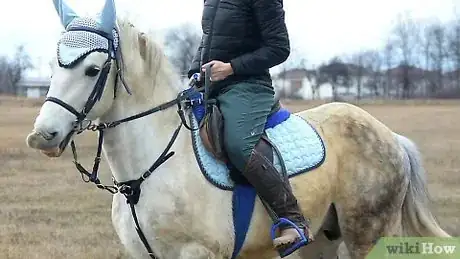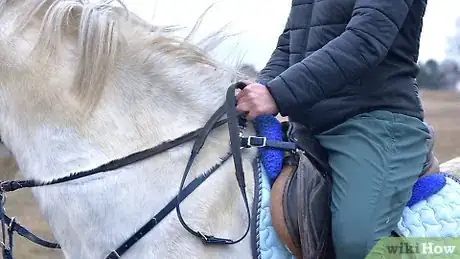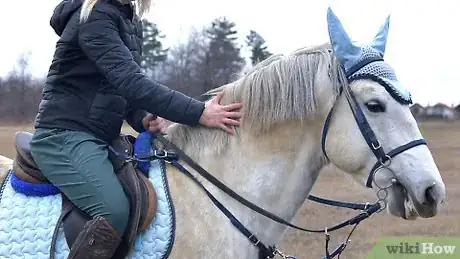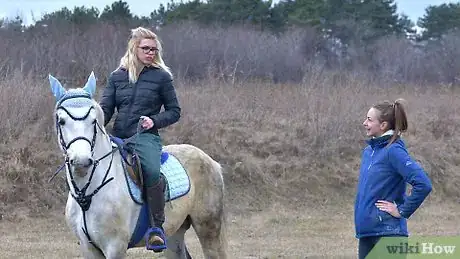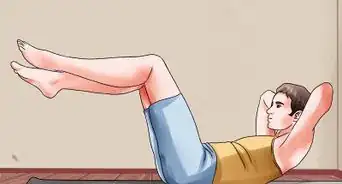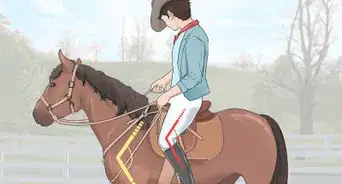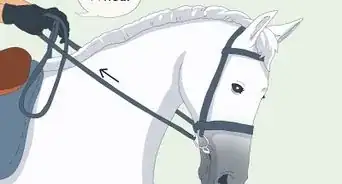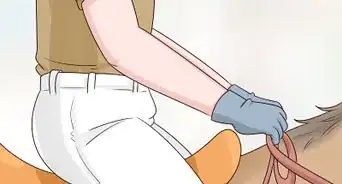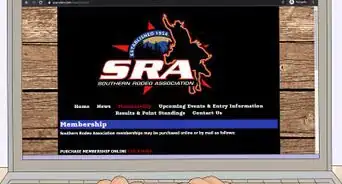This article was co-authored by Kate Jutagir. Kate Jutagir is an Equestrian Specialist, Hunter/Jumper Trainer, and the Owner of Blackhound Equestrian, a premier training barn located on 65 acres in Castro Valley, California. Originally designed to be a riding school used as a springboard for dedicated students into careers in the sport, Blackhound Equestrian has grown into a hunter/jumper training program for all levels focusing on providing a solid foundation needed for personal advancement in the sport. Kate has over 25 years of equestrian instruction and training experience. Her focus on developing horse and rider partnerships provides a complete equestrian education for both beginners and advanced riders alike.
This article has been viewed 938,119 times.
Riding a horse can be a fun experience. However, it takes a great deal of training and experience to learn to ride a horse properly. Make sure you know how to mount, steer, and signal your horse to move properly. Also, you must know how to train your horse and do groundwork with them before riding! Groundwork is the most important thing about riding horses and you must do it every time before riding your horse. Groundwork helps calm your horse and lets your horse know that you're the boss before you get on them!
Steps
Laying the Groundwork for Mounting and Sitting
-
1Mount your horse. The first thing you'll want to do when riding a horse is to do some groundwork. You don't need to do heaps and make your horse tired, but you only need to do a little bit of groundwork! The next thing you will want to do is mount your horse correctly! Many people are intimidated by the idea of mounting a horse but if you stay calm it should be fun and easy.
- If you're a first time rider, it's not a bad idea to use a mounting block. This is a small wooden structure that you can use to stand on in order to mount the horse. [1] You should also ask someone to hold the horse's head as you mount. #*Mount the horse from its left near side. Place your left foot in the left stirrup and launch your body up and over. Next, lift the right leg gently over the horse's back and insert your right foot into the right stirrup.
- Select a well-trained horse if you're a beginner. Horses that are younger or poorly trained may shift and move during mounting. Choose an older horse with a reputation for being calm and cooperative during rides.[2]
- If someone doesn't hold the horse's head as you mount, you should hold the reins tightly in your left hand, but not so tightly that the horse backs away from the pressure
-
2Position yourself for balance. Once in the saddle, take a moment to make sure you're in the proper position for balance. Keep your back straight. Keep in mind when you ride a horse you should be able to draw a straight line through your ear, shoulder, hip, and heel. Keep your shoulders even and straight as well, with the bulk of your weight resting on your seat bones in your buttocks.[3]Advertisement
-
3Get your legs in the right position. Once you feel securely balanced, get your legs into the proper position. This can be particularly difficult for beginning riders so take time to make sure your legs are positioned properly. Keep your heels right under your hips.
- Your legs should be turned inward. Many beginning riders have their legs turned outward, as this can feel more natural, with their knees sticking out. Remember, you're sort of hugging the horse with your legs. You shouldn't squeeze the horse too tightly, but have your legs curved inwards towards the horse.[4]
- Your toes should rest higher than your heels. An easy stretch or practice for this is to stand on something higher than the ground or even a staircase and push your heels down keeping the balls of your feet on the staircase.[5]
-
4Hold the reins properly. Once your legs are in the right position, make sure you're holding the reins properly. How you hold the reins depends on whether you're riding English or Western.
- For English style, make a fist and then pass the reins through the fist so the loop of the reins faces upward. Then, remove both your pinky fingers from the fist and place them on the outside of the reins. Place your thumbs on top of the reins, securing them in place.[6]
- In Western, the reins do not form a loop. The western bridle has reins that are knotted at the top. Keep the reins loose at all times and hold them in two fists.[7]
Riding Basics (English Style)
-
1Learn the different ways to signal your horse to move. When riding English style, there are a variety of ways you can signal your horse to move.
- Starting off, try gently squeezing your horse's side with your legs. This should signal your horse to walk.[8]
- If your horse does not respond to this, he may need further prompting. You can gently kick your horse with your heels. Do not kick too hard, however. While horses have thick hides, they may experience pain if you kick with too much force. A gentle tapping is generally all it takes to get a horse to walk.[9]
- Verbal cues also help in some cases. Depending on how a horse was trained, he may respond to clicking of the tongue and other noises. Ask the horse's trainer if there are any noises he responds to.[10]
-
2Follow the movements of a horses head with your arms. When a horse walks, canters, or gallops, his head moves back and forth with the rhythm of his body. Allow your hands to bob back and forth with the horse's head. Not following the horse's movements can hurt the horse. When starting a canter, let the horse have a lot of rein because they stretch out their neck when cantering.[11]
-
3Learn to steer. It's important you learn how to steer your horse. Steering in English style if fairly self explanatory.
- You keep more contact with the horse's mouth while riding English. To signal the horse to turn right, very lightly pull back with your right hand. To signal the horse to turn left, very lightly pull back with your left hand. If the horse does not respond to the lighter pulling, you can gradually begin to pull slightly harder until the horse responds.[12]
- You should also use your legs and body to signal a horse to move. Looking in the direction you wish to move helps. Horse's can feel your seat bones move. You should also gently squeeze your legs to signal a horse to change direction. For example, squeeze your left leg if you want your horse to turn right as the horse will want to move away from the pressure.[13]
-
4Learn how to trot. Once you're confident at the walk, gently press your legs into the horse's sides to cue the horse to trot. Sit deep in the saddle and keep contact with your legs. Be careful to keep your elbows relaxed, so you don't jerk on your horse's mouth.[14]
- Some riders prefer to do a "posting trot" as opposed to a sitting trot. This can be more comfortable as a trot is a bouncing gait. To do a "posting trot" simply rise when the horses outside shoulder moves forwards, and gently sit back down in the saddle, as to avoid bouncing heavily on the horses back. [15]
-
5Move your outside leg back and squeeze to canter the horse. Cantering is a quicker three-beat speed that's natural to all horses. When you canter, your seat will roll with the canter and you stay in the position you normally ride in. Before you canter, make sure you are comfortable with both posting trot and sitting trot as both of these are major key points. Getting the timing right to get a horse to canter takes time.
- Try not to tense up. Most beginners will find it beneficial to hold onto a saddle or neck strap while learning to canter to help with their balance so they don't fall.
- If your horse just moves into a faster trot when you signal it to canter, ask your horse to walk and continue asking him to canter from the walk instead of the trot. Before learning to canter make sure you know posting trot, and sitting trot. Before cantering, gently squeeze your outside rein to slow your horse to a half halt in a trot before using your inside leg by the girth and then soon adding your outside leg behind the girth to give your horse a bit of a push forward.
-
6Practice more advanced riding as you feel ready. Galloping, jumping, and dressage tricks are all fun to learn in English style. However, you should hold off until you've mastered the basics. Spend at least a few months practicing the above techniques before trying anything new. Galloping and jumping especially can be dangerous if you're inexperienced.[16]
Riding Basics (Western Style)
-
1Learn to neck rein. Steering is slightly different in Western style than it is in English style When riding Western, you use a technique called "neck reining."
- Neck reining means you hold the reins loosely and gently touch the horse's neck to signal movements. [17]
- To turn right, move the reins across the horse's neck to the right. To go left, move the reins across the horse's neck to the left.[18]
- Always hold the reins in your left hand. Keep your right hand on your right thigh.[19]
- As with English riding, make sure you use your full body to steer as well. Use your legs and seat bones in addition to your hands.
-
2Direct rein during emergencies. If you need to steer your horse quickly, it's recommended you momentarily switch to English style steering. If your horse is not responding to neck reining, grab the reins in both hands. Gently pull or squeeze the left rein to turn left and the right rein to turn right.[20]
-
3Walk your horse. Start out walking gently. In Western, you also squeeze your horse to get him to walk. You should follow the motion of his head again, but as you hold the reins looser you might not move your hands as much as you would in English.[21]
-
4Jog your horse. While your horse is walking, squeeze his sides gently to signal to him to jog. Trotting is not usually a part of Western style riding.
Getting Further Training
-
1Take lessons at a stable. Horseback riding can be very difficult and takes a lot of time and patience. Try to find a reputable stable in your area and take lessons from an established trainer. It's a good idea to have supervision when beginning to take riding lessons in case of an injury to you or the horse.[24]
-
2Learn to groom a horse. Horses are groomed somewhat differently, depending on whether they're kept indoors or outdoors. Always refer to the instructions and the guidelines given by the horse's owner. There are some general rules, however. You should usually groom a horse before riding him.
- Use a body brush to brush the horse's fur all over its body, removing the dust, sweat and loose hair from the horses coat. Use the mane-and-tail comb on the mane and tail, appropriately.[25]
- Next, use a dandy brush on the body and legs of the horse, removing mud and sweat. This brush has harder bristles, which shouldn't be used on the face, mane, or tail of the horse.
- Use the hoof pick to remove mud, dirt, and pebbles from the horse's hooves. If this is not done before you ride, your horse may get a sore foot and go lame.
- Use a rubber or plastic curry comb on the body of the horse for removing loose hair and mud from the horses coat. Metal curry combs are used for removing loose hair from horses that are shedding heavily.
-
3Learn to tack and bridle your horse. Before you ride, a horse needs to be outfitted with a saddle and bridle.
- To saddle a horse, position the saddle blanket above the horse's withers and push it back toward the hind-legs to smooth the hair. Place the saddle behind the shoulder and pull the blanket into the empty area at the front of the saddle.
- Attach the cinch or girth and tighten it gently, allowing the horse enough room to exhale comfortably. You should be able to fit two fingers under the cinch or girth, but no more.
- Make sure you've got a bridle appropriate for your horse's size. Gently place the bit near the horses mouth. Most horses will open their mouths as they're used to bridles, but if your horse doesn't gently push your fingers into the sides of the horse's mouth. Slip the bit in slowly, then slip the top of the bridle over the horse's ears. Secure all the straps and buckles, buckling tight enough that you can only comfortably fit one finger under the straps.
Expert Q&A
Did you know you can get expert answers for this article?
Unlock expert answers by supporting wikiHow
-
QuestionHow can I be safe when first learning to ride a horse?
 Kate JutagirKate Jutagir is an Equestrian Specialist, Hunter/Jumper Trainer, and the Owner of Blackhound Equestrian, a premier training barn located on 65 acres in Castro Valley, California. Originally designed to be a riding school used as a springboard for dedicated students into careers in the sport, Blackhound Equestrian has grown into a hunter/jumper training program for all levels focusing on providing a solid foundation needed for personal advancement in the sport. Kate has over 25 years of equestrian instruction and training experience. Her focus on developing horse and rider partnerships provides a complete equestrian education for both beginners and advanced riders alike.
Kate JutagirKate Jutagir is an Equestrian Specialist, Hunter/Jumper Trainer, and the Owner of Blackhound Equestrian, a premier training barn located on 65 acres in Castro Valley, California. Originally designed to be a riding school used as a springboard for dedicated students into careers in the sport, Blackhound Equestrian has grown into a hunter/jumper training program for all levels focusing on providing a solid foundation needed for personal advancement in the sport. Kate has over 25 years of equestrian instruction and training experience. Her focus on developing horse and rider partnerships provides a complete equestrian education for both beginners and advanced riders alike.
Equestrian Specialist & Trainer Absolutely have the benefit of someone who has experience guiding you. You want to read some books and really study horse care and horse behavior. Buy protective headgear and try setting yourself up to work with a horse that has experience so that they can help guide you. The more interaction and the more time you give yourself with the horse, the more skilled you'll become.
Absolutely have the benefit of someone who has experience guiding you. You want to read some books and really study horse care and horse behavior. Buy protective headgear and try setting yourself up to work with a horse that has experience so that they can help guide you. The more interaction and the more time you give yourself with the horse, the more skilled you'll become. -
QuestionAt what age should a rider be when he stops riding horses?
 Community AnswerIt would all depend on the rider, but most healthy people can do it their entire lives.
Community AnswerIt would all depend on the rider, but most healthy people can do it their entire lives. -
QuestionHow do I turn a horse with their mane instead? Like if I am riding bare back.
 Community AnswerWhen your riding bareback you normally just steer with you legs and hold on to the mane, however, you could gently pull left or right. It may not work if your horse isn't obedient, but its worth a go.
Community AnswerWhen your riding bareback you normally just steer with you legs and hold on to the mane, however, you could gently pull left or right. It may not work if your horse isn't obedient, but its worth a go.
Warnings
- If you've never ridden a horse before, have an experienced rider present to guide you.⧼thumbs_response⧽
- Horses are prey animals and are frightened by many people rushing to them at once. If something goes wrong, it is best to have only two or three people approach calmly to help you. One for you, and one or two for the horse should suffice.⧼thumbs_response⧽
- Some places have helmet laws. It pays to be informed.⧼thumbs_response⧽
- Helmets can prevent some brain injuries, but will certainly not protect against a broken arm or bruised rib. They sometimes even encourage a false sense of security and encourage riders to try things they would never attempt without a helmet.⧼thumbs_response⧽
- Other protective gear works similarly to a helmet. They may be a help in certain circumstances, but a horse is strong enough that they are certainly no force-field. They too can encourage uncharacteristic overconfidence.⧼thumbs_response⧽
References
- ↑ http://www.lovehorsebackriding.com/how-to-ride-a-horse.html
- ↑ Kate Jutagir. Equestrian Specialist & Trainer. Expert Interview. 31 March 2020.
- ↑ http://www.lovehorsebackriding.com/how-to-ride-a-horse.html
- ↑ http://www.lovehorsebackriding.com/how-to-ride-a-horse.html
- ↑ http://www.lovehorsebackriding.com/how-to-ride-a-horse.html
- ↑ http://www.lovehorsebackriding.com/how-to-ride-a-horse.html
- ↑ https://rachelshorseblog.wordpress.com/how-to-ride-a-horse-and-about-riding/
- ↑ http://pioneersettler.com/horseback-riding/
- ↑ http://pioneersettler.com/horseback-riding/
- ↑ http://pioneersettler.com/horseback-riding/
- ↑ http://pioneersettler.com/horseback-riding/
- ↑ http://pioneersettler.com/horseback-riding/
- ↑ http://pioneersettler.com/horseback-riding/
- ↑ http://www.lovehorsebackriding.com/horse-riding-for-beginners.html
- ↑ http://pioneersettler.com/horseback-riding/
- ↑ http://pioneersettler.com/horseback-riding/
- ↑ https://rachelshorseblog.wordpress.com/how-to-ride-a-horse-and-about-riding/
- ↑ https://rachelshorseblog.wordpress.com/how-to-ride-a-horse-and-about-riding/
- ↑ https://rachelshorseblog.wordpress.com/how-to-ride-a-horse-and-about-riding/
- ↑ https://rachelshorseblog.wordpress.com/how-to-ride-a-horse-and-about-riding/
- ↑ https://rachelshorseblog.wordpress.com/how-to-ride-a-horse-and-about-riding/
- ↑ https://rachelshorseblog.wordpress.com/how-to-ride-a-horse-and-about-riding/
- ↑ https://rachelshorseblog.wordpress.com/how-to-ride-a-horse-and-about-riding/
- ↑ Kate Jutagir. Equestrian Specialist & Trainer. Expert Interview. 31 March 2020.
- ↑ http://www.thehorse.com/articles/10028/grooming-your-horse-deep-down-clean
- ↑ Kate Jutagir. Equestrian Specialist & Trainer. Expert Interview. 31 March 2020.
- ↑ Kate Jutagir. Equestrian Specialist & Trainer. Expert Interview. 31 March 2020.
About This Article
To ride a horse, start by mounting it using the stirrups on either side of the saddle. Once you're on the horse, sit up straight and turn your feet inward so you're hugging the horse with your legs. Then, hold the reins with both of your hands and gently tap the horse with your heel so it starts walking. To steer the horse, lightly pull back on the reins on the side you want the horse to turn. When you're ready to go faster, gently squeeze your legs into the horse's sides. To learn more from our Veterinary Expert co-author, such as the differences between Western and Eastern styles of riding, keep reading!
